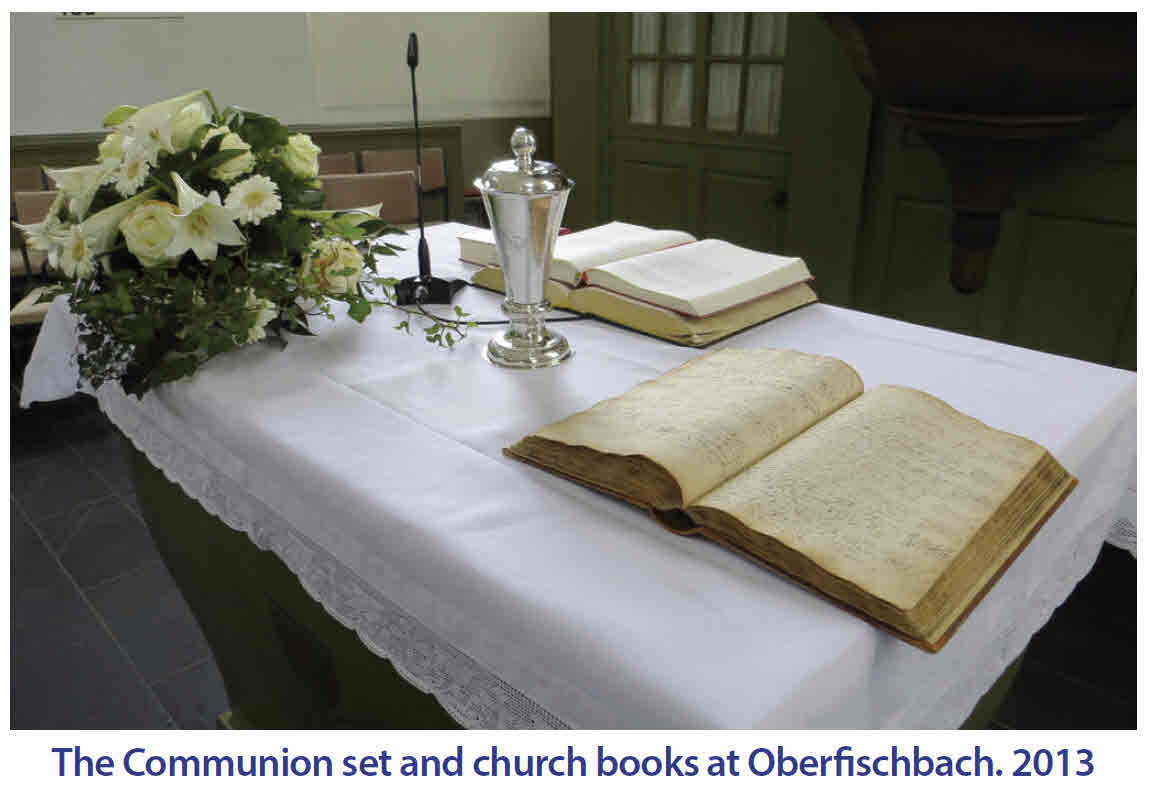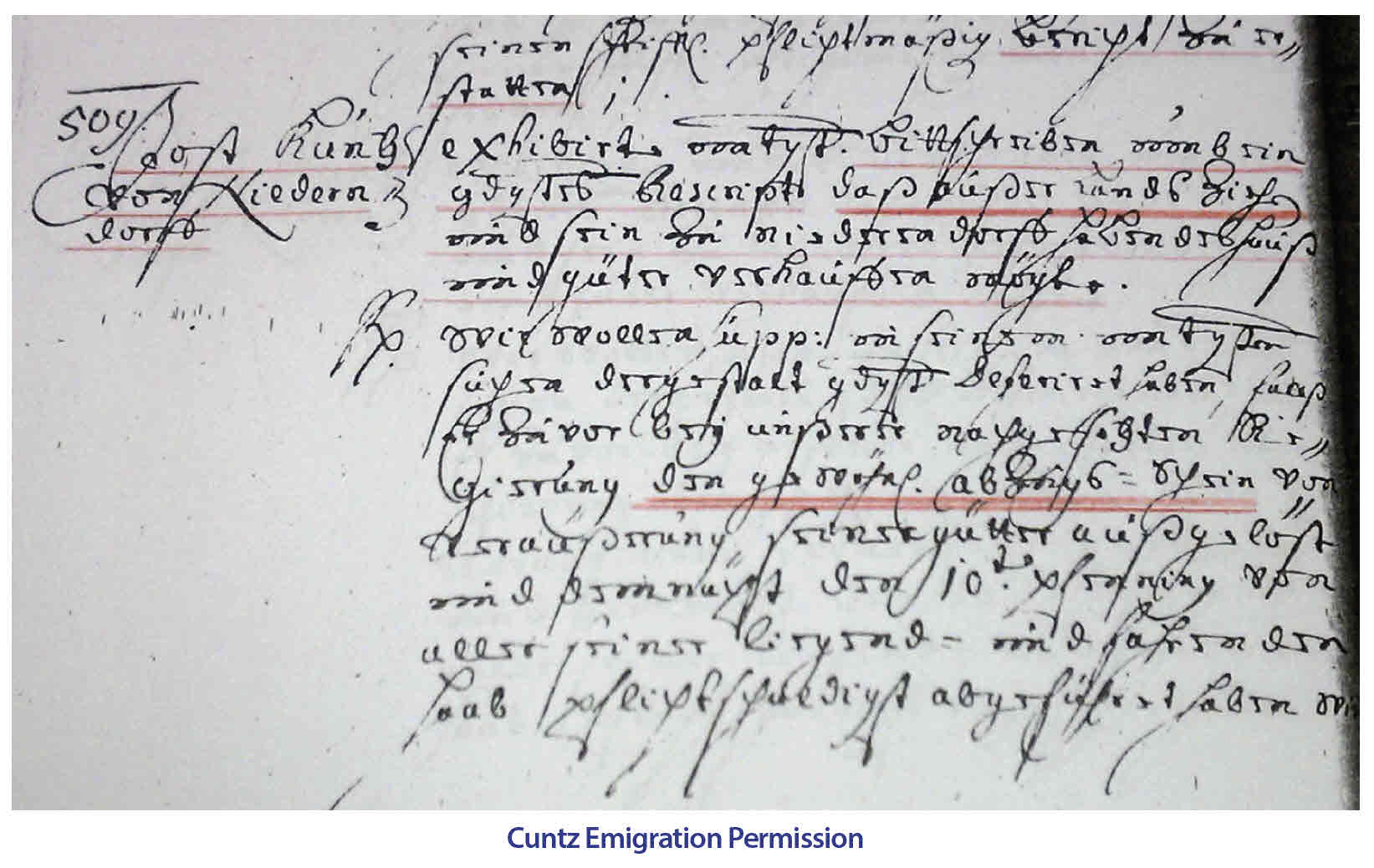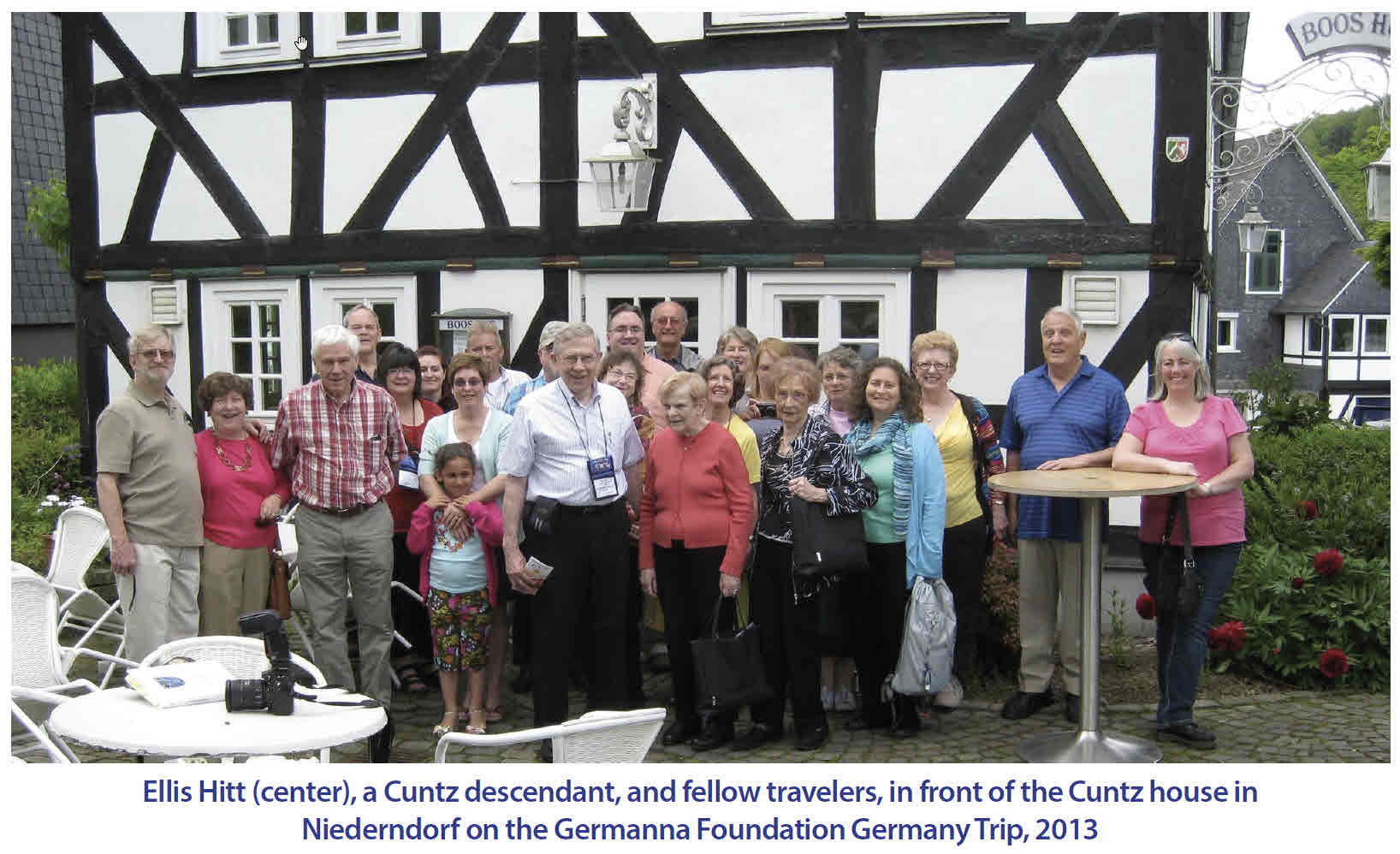By Barbara Price
The Cuntze / Kuntze / Coons family can be traced back to around 1500 in the village of Niederndorf, located in the parish of Oberfischbach, near the city of Siegen.
The family appears to have moved back and forth between Niederndorf and Oberfischbach. (1) The parish of Oberfischbach originated in the 12th century and in 1597 was comprised of the villages of Oberfischbach, Heisberg, Oberschelden, Niederndorf, Dirlenbach, Niederheuslingen, Oberhueslingen and Bottenberg.
In 1665, Prince Johann Moritz of Nassau-Siegen dedicated a silver communion set to the parish of Oberfischbach and it is still in use today, 350 years later.
In 1703, the Rev. Henry Haeger, and his wife, Anna Catharine Friesenhagen, came to Oberfischbach where he was the parson, or minister.
The Kuntze family attended church in Oberfischbach and would have been very familiar with the Rev. Henry Haeger and the schoolteacher, Hans Jakob Holzklau.
Were they an influence on Jost/Joseph Cuntze, and his family, to emigrate to America when Johann Justus Albrecht was recruiting miners for the George Ritter Company in Siegen?
The village of Niederndorf, and home of the Cuntze family, is well known in the mining industry with an iron works dating back to at least 1417.
The owner of the iron works at that time was Tyl van Fispe, the ancestor of the Fischbach/Fishback families. The Kuntze/Cuntz family was also involved in the mining industry.
Johannes Kuntze, the father of the 1714 immigrant, Jost/Joseph Cuntze, and all of his sons, including Jost/Joseph Cuntze, were all members of the Steelsmiths and Toolmakers Guild. (2)
Jost/Joseph Cuntze received permission to leave his country on 31 July 31 1713 (see Emigration Permission below), the same day that Philip Fischbach and Hans Jacob Richter obtained their permission to leave: (3)
Jost/Joseph Kuntze/Cuntze was born in 1674 in Niederndorf, the son of Johannes and Anna (Schuster) Cuntze.
He married Anna Gertrud Reinschmidt on 7 Feb 1704 and along with their children, Johannes and Anna Elisabeth, emigrated in 1713.(4)
The Kuntze home is still standing in Niederndorf and occupied today (see below).
Joseph Cuntz proved his importation to Virginia in 1724, along with his wife, Katharin, and children in the Spotsylvania courthouse:
 It is thought that Joseph’s first wife, Anna Gertrud, died early upon arrival in Virginia and that “Katharin” is the second wife of Joseph Cuntz. She is probably Cathrin Weber/Weaver, the daughter of Johann/John and Anna Margaretha (Huttmann) Weber/Weaver.
It is thought that Joseph’s first wife, Anna Gertrud, died early upon arrival in Virginia and that “Katharin” is the second wife of Joseph Cuntz. She is probably Cathrin Weber/Weaver, the daughter of Johann/John and Anna Margaretha (Huttmann) Weber/Weaver.
Cathrin is not listed in the importation document of her brother, Tillman Weaver, but he does list his mother, indicating that his father is dead, and, as you can see in the document below, Joseph Cuntz lists his wife as being imported in April 1714 and her name is Katharin. (5):
Joseph Cuntz died in 1731, both of his wives preceding him in death, in Germantown, Fauquier Co., Virginia, according to his will that was probated on 10 Feb 1731.(6)
Other members of the Cuntze family also emigrated to Virginia—the nephew of Jost/Joseph Cuntze, Johann Jost/Joseph Coons, and his niece Anna Margarethe Kuntze, both children of his brother, Johannes Kuntze and his wife Catherine Daub, immigrated to Virginia in 1737 and 1750, respectively.
Anna Margarethe Kuntze married Tillmann Weissgerber/Whitescarver, also from the village of Niederndorf. They emigrated to Virginia in 1750 with their 6 children, settling in Culpeper Co., but not with the Little Fork Colony,(7), as it was called, due to its location at the Little Fork of the Rappahannock River in the northern part of Culpeper County.
Johann Jost/Joseph Cuntze/Coons was born in Niederndorf in 1712, the son of Johannes Cuntze and his second wife, Anna Gertrud Stieger.
He emigrated to Virginia in 1737, probably staying with his relatives in Germantown (Fauquier County) before being granted 127 ½ acres in the Little Fork (Culpeper County) on 8 December 1747.
This land was located between the land of two other members of the First Colony, Jacob Holtzclaw and John Fishback, and below the land of John Crim/ Grimm.
John Crim, son of Christian and Elisabeth Spielman Grimm of Oberschelden, was also an immigrant from Nassau-Siegen, and was related to First Colony immigrant John Spielmann / Spilman.(8) This is yet another link to the Germanna immigrants of 1714!
The home of Joseph Coons, the 1737 immigrant, is still standing and occupied in Jeffersonton, Virginia, once part of the Little Fork Colony:.
Jacob Holtzclaw and John Fishback, enterprising members of the First Colony, purchased more than 2000 acres in the Little Fork area in order to settle families here. This was just one of several land ventures in which the two were partners.
This venture was successful in that many of the families of the Little Fork Colony were either relatives or neighbors of the First Colony immigrants and had lived in the Nassau-Siegen area of Germany.
Kinship and settlement patterns in the Little Fork Colony is positive proof of active communication between the members of the First Colony and their homeland.
Sources:
(1) B. C. Holtzclaw, Ancestry and Descendants of the Nassau Siegen Immigrants to Virginia 1714-1750, (Virginia, The Memorial Foundation of the Germanna Colonies in Virginia 1964), 89-93.
(2) Ibid, 91.
(3) Furstentum Siegen Landesarchiv 11, No. 28th.
(4) Holtzclaw, Ancestry and Descendants of the Nassau Siegen Immigrants to Virginia 1714-1750, 93
(5) Will Book A, Spotsylvania County, Virginia, 74.
(6) Stafford County, Virginia Will Book 1729-48, 22.
(7) Holtzclaw, Ancestry and Descendants of the Nassau Siegen Immigrants to Virginia 1714-1750, 92, 95, 520.
(8) B. C. Holtzclaw, “The Little Fork Colony “in The Story of Germanna Descendants in Reunion at Siegen Forest Virginia, (Virginia, The Memorial Foundation of the Germanna Colonies in Virginia 1960), 10.
This article was first published in the Spring 2014 edition of the Germanna Foundation newsletter. Get our newsletters delivered to your home by becoming a member.





